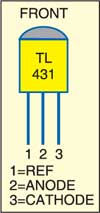 The life expectancy of a battery dramatically reduces when it is discharged below the minimum recommended battery voltage. You must disconnect the load before discharging is complete. Otherwise, it can damage the battery or shorten its life.
The life expectancy of a battery dramatically reduces when it is discharged below the minimum recommended battery voltage. You must disconnect the load before discharging is complete. Otherwise, it can damage the battery or shorten its life.
This disconnect function requires a battery voltage monitor with considerable hysteresis to prevent chattering in the disconnect switch. Chattering occurs as the battery voltage drops below threshold and then bounces back on load removal.
Battery protector circuit
This simple circuit outperforms the usual battery protectors. It uses shunt regulator IC TL431 for its simplicity and marvelous functioning.

It’s easy to set the operating point of the circuit with a regulated workbench power supply. The adjustment procedure follows: First, short zener diode ZD1 with a jumper. Feed 12V DC to the circuit. Relay RL1 energises. Now reduce the power supply to 10.5V and adjust preset VR1 to make the relay trip at 10.5 volts. (Refer the voltage recommended by the battery manufacturer.) If necessary, repeat the procedure.
 Now remove the jumper and connect the circuit. The relay should not work at 10.5V. Slowly increase the power supply. When it crosses 12 volts, the relay pulls in, which is decided by the relay pull-in voltage and the zener breakdown potential. Reduce the workbench power supply to 10.5V and see the relay trip exactly at 10.5V.
Now remove the jumper and connect the circuit. The relay should not work at 10.5V. Slowly increase the power supply. When it crosses 12 volts, the relay pulls in, which is decided by the relay pull-in voltage and the zener breakdown potential. Reduce the workbench power supply to 10.5V and see the relay trip exactly at 10.5V.
A large hysteresis is also possible by using a zener diode of little higher voltage. We have tested the circuit with a 3.9V zener diode and a 12V, 200-ohm relay, which is sufficient to avoid relay chattering.
The article was first published in October 2006 and has recently been updated.








